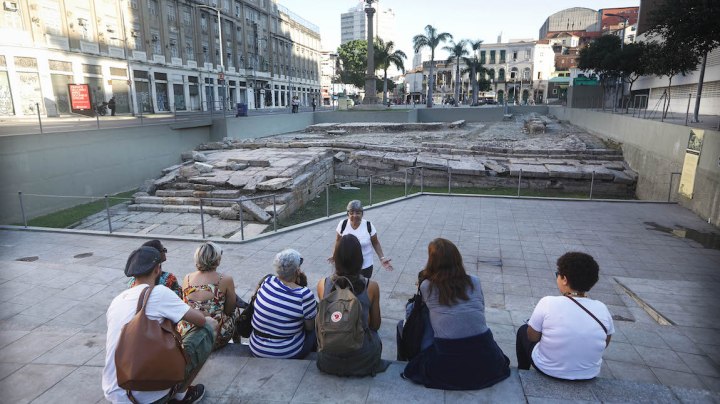This Immersive App Provides a Much-Needed History Lesson About Rio de Janeiro’s Largest Slave Port

Visitors gather at the Valongo slave wharf, entry point in the Americas for nearly one million African slaves, on July 11, 2017 in Rio de Janeiro, Brazil. Photo by Mario Tama/Getty Images
Hidden underneath a paved street and car park in Rio de Janeiro is a surviving trace of Brazil’s long and dark history of slavery: the Valongo Wharf, the city’s largest slave dock. An estimated 900,000 enslaved Africans were unloaded there. The many who didn’t survive the voyage were buried in a nearby cemetery; the ones who made it to Brazil alive were sold off. But first, they were kept in the wharf area to recover from a tortuous trip that left them emaciated.
This little-recognized history gained worldwide attention in 2011 when construction workers installing a light rail in Rio’s port area discovered the massive stones of the city’s old slave dock, according to The New York Times. Six years later, UNESCO declared Valongo Wharf a world heritage site, describing it as “the most important physical trace of the arrival of African slaves on the American continent.” The United Nation’s cultural organization added that the site should have the same place in history as Hiroshima and Auschwitz.
The importance wasn’t lost on the team at Agência Pública – a nonprofit journalism initiative – so it designed a smartphone app that allows everyone to uncover the past of the wharf with a tap of a smartphone screen and some footwork. Inspired by the Pokemon-Go app’s augmented reality, the Museum of Yesterday makes the user “an investigator of this secret past.” The app’s name is a play on The Museum of Tomorrow, the $55 million establishment that opened nearby, in the historic port district, in December 2015. The museum, as well as other projects that have taken place as part of the government’s $2 billion revitalization of the port, has received its fair share of criticism for gentrifying the area, according to NPR.
And as the area changes and the displacement of those who called the district home for generations occurs, it’s especially important that Afro-Brazilians’ past isn’t erased or forgotten. And the Museum of Yesterday wants to play a role in that, and is ensuring this history isn’t kept behind the inaccessible doors of college classrooms.
For now, only those in Rio can access the app. While physically walking through the port, users can uncover events that occurred on the site, from the selling of enslaved Africans to Isabel, Princess Imperial of Brazil, signing the Lei Áurea in 1888, which ended slavery in the country.
The Museum of Yesterday is free and currently available on iPhone, iPad, and iPod touch. Users can unlock all of the app’s features, including five tours – such as The Corruption Tour, the Terror Tour, The Samba Tour, the Ghosts Tour, and the Brazil History Express Tour – 160 stories from the region, a map from 1830 and rewards for conquests, among other features. Soon, Pública will make the “virtual tour” available outside of Rio, giving everyone access to a new story each time they take 164 feet – regardless of where they are.
Check out NPR’s new story about the app below:
[H/T NPR]